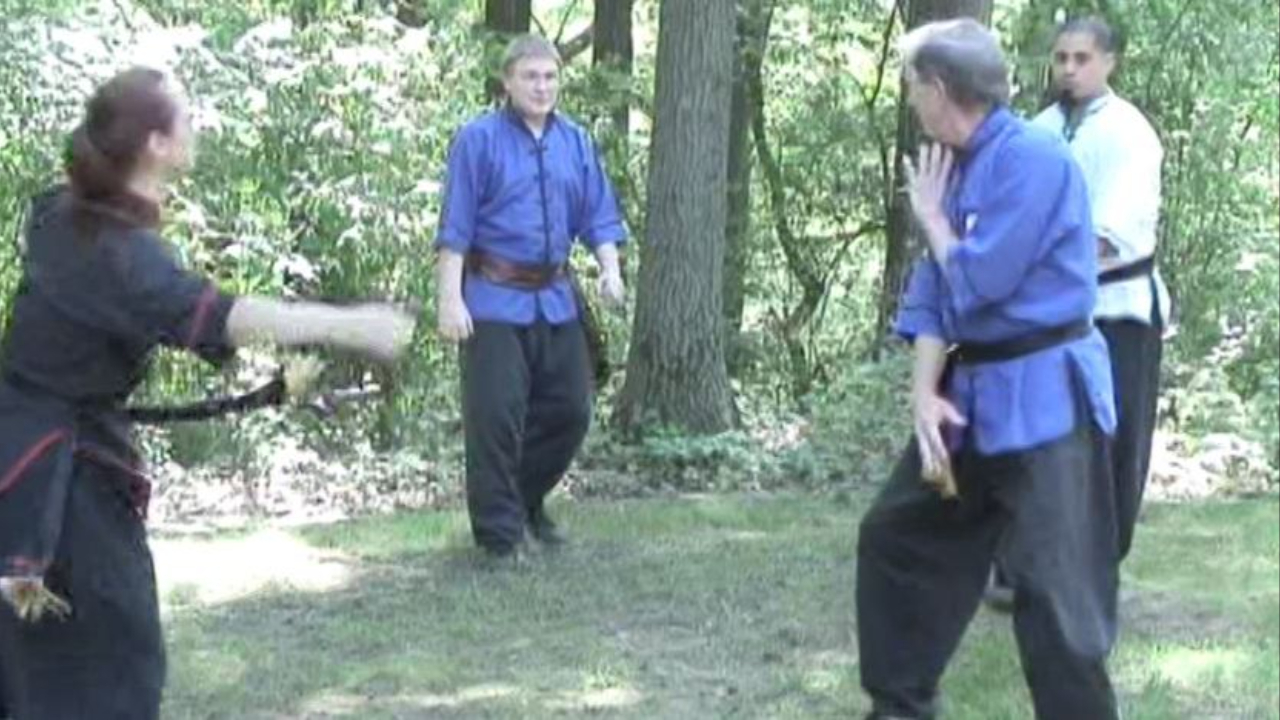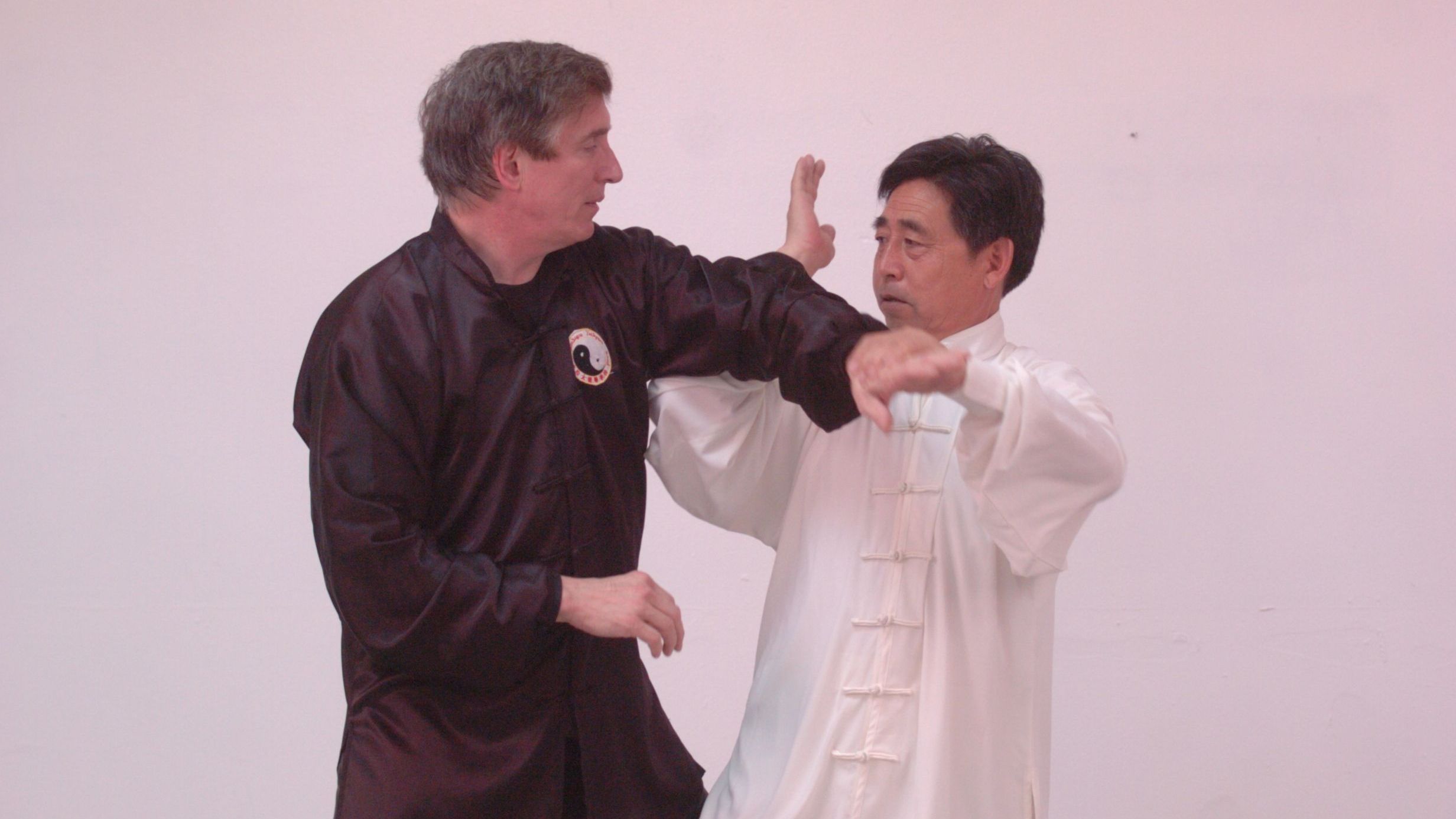No Pain, No Gain - and No Quality in Your Tai Chi

I love seeing the look in the eyes of new students who come in thinking of Tai Chi as a gentle means of "moving meditation" and then they find out what it really takes.
I have a couple of wonderful new students -- great young people -- who started two or three weeks ago. Last night we were working on the double-hand silk-reeling exercise, as I introduce them to the body mechanics required for taijiquan.
"You must have legs of steel," one student said after we had practiced a while and they were ready to stop and rest while I was still demonstrating and practicing with them.
Actually, I lost a lot of leg strength when I had my brush with death about 18 months ago and I'm still trying to regain it, but the comment last night made me laugh, and it also drove home just how difficult taiji really is.
When I've trained with my teachers and with members of the Chen family, as in the photo at the top of the page showing me training privately with Chen Xiaoxing, I've generally come close to...
If You Don't Do the Type of Qigong I Do You Will Die

Some people are living in the Twilight Zone.
I've been through a lot during the past three years. The onset of atrial fibrillation, three procedures to try to fix it, and the horrible side-effect, which was the closing of my left pulmonary veins.
No blood is going to my left lung. No blood is being oxygenated by the left lung because no blood can go from my left lung to the heart.
The same procedure that caused my pulmonary veins to shut down also paralyzed my right diaphragm. So I'm living -- and doing kung-fu -- with 2/3 of one lung.
It can be a challenge.
For over a week at Cleveland Clinic in late 2009, I was on a ventilator. The photo above is from that time. I nearly died twice. My weight dropped from 206 pounds to 157. I lost a lot of muscle. I looked like a concentration camp victim. I was determined to recover and to do kung-fu again -- tai chi, hsing-i and bagua. It has been a struggle. Even though I'll never be able to use my left lung, and the right diaphragm is stil...
How Long Does it Take to Achieve Tai Chi Skill?

A couple of cool things happened this week. On Monday, I drove to Rockford, Illinois to reconnect with my old instructors, Jim and Angela Criscimagna. Angela was visiting a friend, so Jim and I talked about taiji and he coached me through some Xinjia movements, giving me new insights into the body mechanics, the principles and the form.
I first met Jim and Angela in 1998. I was using a neijia listserve and seeing internal terms that I hadn't been taught -- terms like peng jin and ground path. I asked the list (Mike Sigman was one of the main contributors at that point) if there was anyone in the Chicago area that I could meet who could show me some of these concepts.
They directed me to Jim and Angela. I drove to their house one Saturday morning and within an hour, I realized that after spending over a decade studying tai chi, I was going to have to start over. I had really learned nothing about real taijiquan.
The best thing about a good teacher is this -- you should leave a class ...
The Circle of Death Practice for Taiji, Xingyi, and Bagua

In our practices in the Quad Cities, we enjoy doing the Circle of Death. Here's how it works.
One person gets in the center of the circle and ha so defend as the people on the rim of the
circle attack one-by-one. Sometimes we do it empty hand and the defender must defend with just Hsing-I, just Tai Chi, or just Bagua techniques.
Sometimes we do it with weapons, as we did tonight. We each took turns in the center (including me) and defended with one weapon as others attacked with different weapons, including staffs, broadswords, straight swords, and elk horn knives.
It's always fun, and it gives you a chance to think on your feet and learn how to respond to different attacks.
It's important for the instructor to watch carefully, and if a student doesn't get a reaction right, they should be asked to do it again. The importance of this drill isn't to humiliate the student -- the importance is to have them internalize the actions that it takes, and the techniques required, to defend...
What Does "Jin" Mean When Talking about the 8 Energies of Taijiquan?

The Chinese language is complex to Westerners, and some of the terms of the internal arts such as Tai Chi, Hsing-I and Bagua are misinterpreted because of the way the words are translated. As a result, the internal arts are often described as "mysterious" or "mystical." That makes them seem out of reach. It harms our practice and our understanding, and these injuries are self-inflicted.
In Taiji, there is a concept known as the "energies," that include peng (ward off), lu (roll back), ji (press), an (push), etc.
The most important of all these is peng jin -- peng energy. It is one of the key elements of every movement, even when you step. You should never lose peng, and that is something that I see missing when I meet Tai Chi students, particularly those who have not studied Chen style. If you have studied Taiji and your teacher hasn't stressed and shown you how to maintain peng in all movement, you should be asking some serious questions about the quality of what you're learning.
S...
An Editorial -- We Need to Dispense with the Tai Chi Fantasy in the National Magazines

There has always been a strange willingness in the national Tai Chi and Kung-Fu magazines to print fantasy as if it is fact. They have shown frauds and con artists posing as "chi masters" knocking people down without touching them. Anyone with an ounce of intelligence or reasoning skills understands that this can't happen. Yet the magazines allow almost anyone to claim the most miraculous of powers.
In the two recent issues of Tai Chi magazine, there have been photos that are absolutely impossible to achieve in real life unless you have a partner who is willing to bend the truth and play along on your behalf.
Anyone who has ever been in a real fight knows that another man who is motivated does not generally go down easily, and when adrenalin is flowing, sometimes he doesn't even feel pain as he normally would.
So the magazine prints articles written by students with photos showing their teachers demonstrating impossible feats of "chi." The student/writer plays along in the photograp...
How Tai Chi, Hsing-I and Bagua Techniques Overlap in Self-Defense

In class the other night we were practicing Heng Chuan, Hsing-I's "Crossing Fist," against a roundhouse kick. The photos are shown here.
In photo one, the attacker (Leander Mohs) throws the kick.
In photo two, I absorb the kick with my left arm and cross my right arm under the attacker's calf.
In photo three, I apply pressure to the outside of his leg and push inward, bending it at the knee.
In photo four, I apply a paring, splitting palm to the knee and he goes down. He has to go down. He has no choice.
When you practice this, you realize that the application is the same as the opening for the Chen Tai Chi movement "Fair Lady Weaves at Shuttles."
And this is something we see across the three internal arts that we practice. Several of the principles and palms of Bagua are also in this application, including Blocking, Twining or Snaking, Upward Palm, Outward Palm and Splitting Palm. Dan T'ien rotation is always applied, regardless of the art, and when the kick comes in, ...
A Very Funny Song about Kicking Some Glutes -- the Kung-Fu Remix

Okay, I had some fun on a snowy day. I took this very funny little song, sampled some Queen and threw in some of my tournament sparring clips. Here is the result.
The Hazards of Training Too Hardcore

I ran into a kung-fu guy that I hadn't seen in at least a year. He's young (around 30), strong -- and I asked where he had been. He moved to Chicago a while back and he told me he had started training with a martial artist who "trains real hard" with his students. He said that as if hardcore training was something to be proud of.
How's that going, I asked. He replied that they trained so hard, he had broken his foot and fractured several ribs.
He hasn't trained in over a year.
What? I mean, WHAT?????
There is a big segment of the population now -- the ones who would have been training in kung-fu, karate and TKD schools back in the 1970's -- who now believe that the only "real" martial arts are the MMA and UFC type.
Let me make a point that I've made many times. You don't have to hurt someone, or be hurt yourself, to learn how to be a good fighter. It's a myth fueled by youth, testosterone, and frankly, being a dumbass.
That doesn't mean there isn't a certain amount of pain you ha...
A Good Training Exercise -- Freestyle Sparring with Weapons

If you're going to learn forms with weapons, you should learn how to defend yourself with that weapon.
When martial arts were created, the gun was not yet a weapon. Warriors used sticks, staffs, spears, swords, and other weapons.
In our arts, we learn forms that include the staff, straight sword, broadsword, spear, and elk horn knives. We also practice single and double sticks, although they are not part of our internal curriculum.
Here's a great exercise -- and for this, you should pad up or use foam weapons. It's very important not to thrust at someone's face, and if you're going to allow non-contact thrusting to the face, everyone should have head gear that covers the face and goggles for the eyes. I've never believed in hurting anyone, or being hurt, just to learn martial arts.
This article shows photos taken last week at our practice. Chris Miller (black sash), Kim Kruse (brown sash), and I took turns in the middle and had to defend and counter while we were being attacked...
